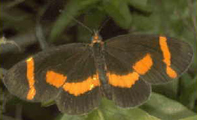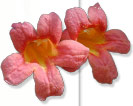Explore Plants
Native Plant Database
Search for native plants by scientific name, common name or family. If you are not sure what you are looking for, try the Combination Search or our Recommended Species lists.
Ilex vomitoria Ait.
Yaupon, Yaupon holly
Aquifoliaceae (Holly Family)
USDA Symbol: ILVO
USDA Native Status: Native to U.S.
Yaupon is a picturesque, upright, single- or multi-trunked shrub or small tree, growing 12-25 ft high. Female plants produce prodigous amounts of bright red, persistent berries. The leaves are dark-green and small, usually less than 1 1/2 in. long. The pale gray bark is marked with white patches.
The ornamental twigs with shiny evergreen leaves and numerous red berries are favorite Christmas decoration. Yaupon Holly is sometimes grown for ornament and trimmed into hedges. The leaves contain caffeine, and American Indians used them to prepare a tea to induce vomiting and as a laxative. Tribes from the interior traveled to the coast in large numbers each spring to partake of this tonic.
View herbarium specimen from Harry T. Cliffe Bexar Regional Herbarium.
Plant Characteristics
Duration: PerennialHabit: Shrub
Root Type: Tap
Leaf Retention: Evergreen
Leaf Complexity: Simple
Size Class: 12-36 ft.
Breeding System: Dioecious
Fruit Type: Drupe
Size Notes: 12-25
Leaf Color: Green
Fruit Length: Red
Bloom Information
Bloom Color: WhiteBloom Time: Apr , May
Distribution
USA: AL , AR , FL , GA , LA , MS , NC , OK , SC , TX , VANative Distribution: S.e. VA to FL, w. to AR & s.c. TX
Native Habitat: Frequent in low woods, hammocks, and sandy pine lands in east and south central Texas. Sand, loam, clay, limestone; poor drainage okay. Low, maritime woods; hummocks; sandy pinelands
USDA Native Status: L48(N)
Growing Conditions
Water Use: LowLight Requirement: Part Shade
Soil Moisture: Moist
CaCO3 Tolerance: Low
Cold Tolerant: yes
Soil Description: Sandy to gravelly soils; tolerates poorly drained soil. Sandy Sandy Loam Medium Loam Clay Loam Clay Limestone-based
Conditions Comments: Yaupon is a versatile plant that tolerates drought and poor drainage, with best production of red fruit when shrub gets half a day of sun or more. Nursery plants are typically female (fruiting) and are propagated by cuttings. You must have both a male and female plant to have berries. The male must be the same species as the female and bloom at the same time. It is slow-growing and tends to get thick and twiggy on the inside. Careful pruning creates an elegantly-shaped plant. Good late winter source of food for many bird species.
texas comments: Yaupon is a versatile plant that tolerates drought and poor drainage, with best production of red fruit when shrub gets half a day of sun or more. Nursery plants are typically female (fruiting) and are propagated by cuttings. You must have both a male and female plant to have berries. It is slow-growing and tends to get thick and twiggy on the inside. Careful pruning creates an elegantly-shaped plant. It is a good late winter source of food for many bird species.
Benefit
Use Ornamental: Understory tree, Accent tree or shrub, Fruits ornamental, AttractiveUse Wildlife: Fruit-birds, Fruit-mammals, Nectar-insects, Nesting site.
Use Medicinal: The young leaves contain caffeine and may be used to make a tea. In high doses, the tea is emetic, hence the name vomitoria.
Conspicuous Flowers: yes
Attracts: Birds , Butterflies
Larval Host: Henrys Elfin butterfly
Deer Resistant: Moderate
Butterflies and Moths of North America (BAMONA)
Ilex vomitoria is a larval host and/or nectar source for:|
Elf (Microtia elva)  Larval Host |
Propagation
Propagation Material: Semi-hardwood CuttingsDescription: Seeds germinate best if planted immediately after collection. They may be pretreated with double-stratification
Seed Treatment: Some benefit may be obtained from 30-60 days treatment at 68-86 degrees followed by 60-90 days of 41 degrees.
Commercially Avail: yes
PlantWise: Native Alternatives to Invasive Plants
Ilex vomitoria (Yaupon) is a PlantWise native alternative for: Ligustrum japonicum (Japanese privet)
Nandina domestica (sacred bamboo)
Phyllostachys aurea (golden bamboo)
Pyracantha coccinea (scarlet firethorn)
Mr. Smarty Plants says
Question: I need advice on what tall evergreens I can plant along a fence line for privacy. I need trees that will be at minimum 8 to 10 feet tall at maturity, are aesthetically pleasing and provide privacy.
click here to view the full question and answer
Question: Mr. Smarty Plants, Please recommend a tall, thick shrub to conceal the 6 foot chain link fence around the perimeter of our property. The fence is located down a hill from our home with western exposure and full sun. While we can run a soaker hose down there to establish the roots, I would love to have tall shrubs that will conceal the fence, act as a noise barrier from the street and require no watering throughout the summer. Is there such a plant? The nursery recommended red tip photinias but after reading your article about disease with these plants, I'm reconsidering. Thank you for your advice.
click here to view the full question and answer
Question: I want to incorporate a tree in my landscaping near my house (10-15 feet) for privacy, what are the best trees that don't shed their leaves and have nice flowers and their roots wont destroy my foundation?
click here to view the full question and answer
Question: I live in Austin in a neighborhood that is bordered on one side by highway 183 and on the other by MoPac and the train tracks. Even though I am least a three blocks from the closest highway, the traffic noise is horrific on all sides of my house, even at night. What might the best native plant or plants to put near the house to mitigate the noise coming inside and to plant around the perimeter of the property for the same purpose? I have a large yard, which I like, but I notice that the smaller properties, with smaller yards and close-by houses on all sides, are quieter because the buildings shield each other from the noise. Thank you for any suggestions.
click here to view the full question and answer
Question: Is there some kind of drought resistant bush or thorny plant we can rim our property with to stop all the foot traffic through our yard? We don't care if it's pretty, just something thick and/or thorny to stop people wandering through our property day and night. We have over an acre lot which is near IH35 and would like some privacy. We have bamboo on one side which works nicely, but can this be transplanted to grow on the empty side of our yard? Thank you!
click here to view the full question and answer
From the National Organizations Directory
According to the species list provided by Affiliate Organizations, this plant is on display at the following locations:Lady Bird Johnson Wildflower Center - Austin, TX
Texas Discovery Gardens - Dallas, TX
Brackenridge Field Laboratory - Austin, TX
Patsy Glenn Refuge - Wimberley, TX
Bibliography
Landscaping with Native Plants of Texas and the Southwest (1991) Miller, G.O.Native & Naturalized Woody Plants of Austin & the Hill Country (1981) Lynch, D.
* Native Alternatives to Invasive Plants (2006) Burrell, C. C.
* Native Texas Plants: Landscaping Region by Region (2002) Wasowski, S. & A. Wasowski
Texas Wildscapes: Gardening for Wildlife (1999) Damude, N. & K.C. Bender
Trees of Central Texas (1984) Vines, R. A.
Search More Titles in Bibliography
Additional resources
USDA: Find Ilex vomitoria in USDA PlantsFNA: Find Ilex vomitoria in the Flora of North America (if available)
Google: Search Google for Ilex vomitoria
Metadata
Record Modified: 2007-01-01Research By: TWC Staff


